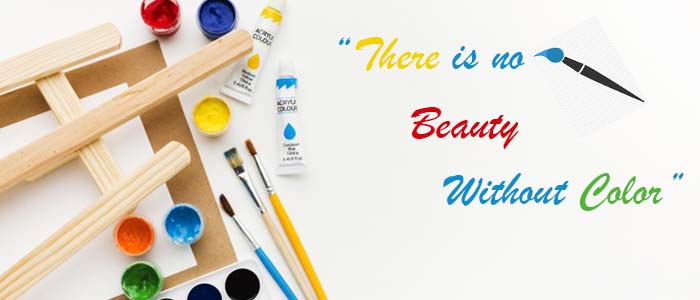Introduction
Whatever we see with our eyes is called a visual. And the shades that we see things in are simply called colors. But there is a lot more than just ‘shades’ in color theory. A theory of color fundamentals basically deals with all that goes into explaining different psychological perspectives of colors and their related phenomenon. In 2025, it will be difficult to gather all the concepts and theories together in one small read. However, we have tried to pack all the misunderstandings and the concepts and theories that can help understand color theory.
We Have Covered The Following Topics in This Post
- Color Theory Misunderstood
- Color and its Fundamentals
- Our Perception and Color
- See For Yourself
- Color Theory and Color Wheel
- Modern Color Theory
- In-depth Scientific Understanding
- Colors, Branding, and Emotions
- Why Do Brands Consider Color So Much?
- What to Consider in Your Logo for Those Who are Color Blind?
- What Color is Your Brain?
Color Theory Misunderstood
When you search on the internet with the keyword “color theory”, many articles spreading too much misinformation on the subject will show up. Some define it as a set/guideline used by designers to facilitate their customers. Or some only rely on the color wheel to explain the entire color theory. However, there is much more than that color wheel into color theory. Neither is it a tool for designers only. Color theory is misunderstood by many people because of such unresearched material. Before we begin with the theory and color wheel, here are some basic definitions that will help understand the said theory in a sophisticated manner.
Read more: Top 10 Digital Marketing Trends In 2025.
“The following definitions have been carefully extracted from the book ‘Color Theory and its application in Art and Design’ ”
~ George A. Agoston
Looking for an Affordable
Logo Design Services
Get in touch with our 24/7 available representatives now!
Chat With us to avail 30% OFF
Color and its Fundamentals
Color is perceived to be a ‘property of materials’. In everyday life, whatever we see around us is some sort of material (in any state of matter), and the association of its visibility to our eyes is called the color of that material. We associate everything to our perceptions with their colors. We all know what color the sky is. Blue! Of course! Oh, wait, it’s Gray. Is it blue or is it gray? We will leave that to you for now.
Our Perception and Color
Whenever we buy a new t-shirt, we come home and register its color to our eyes in bright white light or daylight. And then that color is associated with the t-shirt. Now even if it looks different shade at night, we are not bothered. For example, you are wearing a shirt that you know is gray and someone meets you and says that the color of your shirt is sky blue. What would you tell that person?
Maybe you will begin by telling them that no, it is actually gray, but because of lighting conditions, it appears sky blue. This is a simple phenomenon of our association of colors with objects. For the one who saw it in a different light and thought it was sky blue was right in his place. But you will insist that it is gray – no matter what. So, now we know that color is all about the presence of light. Everything can change its colors according to the available light. Basically, the light emitted from every object is what we see.
See For Yourself
One more example of seeing one color in two different shades is an experiment that anyone can perform to experience it. Take two sheets/papers, one in gray color and one in dull red. Now draw a circle in the middle of both the sheets with green color. Make sure that the green color is exactly the same for both sheets. Now on observation, the same green color will look entirely different on both the sheets. This phenomenon is explained as ‘simultaneous color contrast’.
Color Theory and Color Wheel
Before we begin, it is important to understand what is color theory. Usually, the color theory psychology is referred back to the color wheel invented by Isaac Newton in 1666. That stands true for the invention of color wheel basics by Newton, but the theory has been evolved since then. There have been many modifications and amendments in this theory according to changing trends of art and design. First, let’s demonstrate what a color wheel is.
A color theory wheel is an organization of primary colors: red, yellow, and blue. And all the other hues and shades in a logical sequence or order. There are three main classifications in color wheel: Primary Colors, Secondary colors and Tertiary Colors.
As discussed above, primary colors include red, yellow, and blue.
The secondary group of colors consists of the combinations of colors from the primary group. But those combinations are not random to avoid confusion and random results. Therefore, only three colors have been organized in this group and they are Green, orange, and purple.
Then we have the third group, where color is formed by mixing a secondary color with a primary color. This list can include a lot of tertiary hues. Some of them are:
blue-green, yellow-green, red-purple, red-orange, yellow-orange, and blue-purple.
Now we move forward to understanding what a modern color theory has to offer.
Modern Color Theory
Although not very modern but at least an update of Newton’s theory that was proposed back in the 16th century is presented below. This theory is inspired by the Book titled Color Theory and its application in Art and Design” by George A. Agoston.
Most of the objects that we see are non-luminous (do not emit their own light). It means that the colors of the objects that we see are because of the light falling on their surface and then scattering of that light. This light from the luminous objects such as a lamp, sun, or any light source, can fall directly on the objects or it may go to their surface after falling on some other material. For example, your side table may not be directly under the lamp and the light from your ceiling light falls on it after falling on the bed.
More to know: How To Design A Logo?
In-depth Scientific Understanding
The absorption of light in the receptor cells results in a complex process of generating and modifying electrical potentials to produce four receptor signals that are further modified by intercellular connections and finally coded into a light-dark and two-color difference signals. These three coded signals are converted into electrical spike discharges by the top layer of nerve cells; they are then transmitted by optic nerve fibers to the cortex of the brain.
Colors, Branding, and Emotions
some colors. For example, if a normal audience is asked what brand comes to their mind when they see the color “Red”. Most of the people say “Coca-Cola”, the remaining might say Levi’s. But not many variations can be expected because these brands have enforced that they are represented by the Red color.
Similarly, in the world of digital media, what website is represented by classic blue color? A natural answer is Facebook. What logo has blue, red, yellow, and green colors in it? Google. By the way, Microsoft also has the same colors as Google, but not many people directly think of that. This is because of their frequent interaction with
Helpful tips for you: Mastering Color Theory: Your Ultimate Guide
Why Do Brands Consider Color So Much?
The answer can be found in the above discussion. But for more simpler understanding, Colors have a deep connection with our emotions, according to Psychology. Some colors are considered as more energetic and passionate, while others exhibit peace and harmony. The warmer colors such as red, orange, yellow are associated with energy and passion. Whereas the cooler colors like blue, purple, green express serenity and calmness. The gray family advocates earnestness and seriousness.
White
White shows peace, simplicity, and minimalism
Black
Black represents something serious and sophisticated
Gray
Gray signifies earnestness and professionalism
Brown
Brown gives a feeling of familiarity and friendliness
Red
Red shows energy and passion
Purple
Purple is the definition of tranquility and serenity
Green
Of course, close to nature and refreshing
What to Consider in Your Logo for Those Who are Color Blind?
Color blindness has many different degrees and variations. Some people might not be able to pick few basic colors when mixed with other similar colors. While other people with this deficiency may experience difficulty in identifying colors in dark. When deciding the colors for your brand, make sure that there is no amalgamation of primary colors in a way that can confuse the people with color blindness. According to statistics, there are around 350 million people in the world that are color blind. Meaning that you might miss out on quiet a big chunk of population by making any mistake with the color selection.
Experts suggest that the colors of any brand should not exceed more than three different shades. To keep it simple, unique, and neat, it is always recommended to go for the colors that suit your brand’s personality and do not exceed more than three colors. Exceptions are always there such as Google (they already claim that they don’t follow the rules).
What Color is Your Brain?
When we talk about color schemes and color theory psychology, neglecting this amazing concept of Colored Brains by Arthur Carmazzi, will be total injustice. This is a great concept that was introduced by Carmazzi and is still valid and doing wonders.
This is not just a theory but more of a deterministic test where you have to answer a series of questions and then, based on your answers, a graph is generated by the total score that you got on the test. That graph locates your brain color out of one of the four colors, including Blue, Green, Purple, and Red.
According to Colored Brain team, these colors correspond to the brain’s functionality. It’s not that any of the four colors is more superior than the others. But all four represent the difference of processing that our brain does. For example, Green shows the chaotic processing of information. The Blue brain is associated with intuitive processing. The red one processes everything in a linear manner. While the purple one is associated with relational processing.
What this test does is that it not only determines your brain color but also tells you how exactly your brain processes the information. What patterns does your brain follow when processing anything? This helps in understanding the complexities of our own brain. It also helps us identify the different patterns of thinking and processing information.
More for you to know: Unveiling How Colors, Fonts, and Shapes Influence Customer Behaviour in Logo Design.
Conclusion
Although many theories and definitions have been discussed above, but few things are constant among all of them. One being the very fact that certain colors represent certain emotions. This is indeed a constantly true concept and stands valid even today. Secondly, the color spectrum that was represented on a color wheel by Newton will remain a very big contribution in all the theories associated with Colors.





